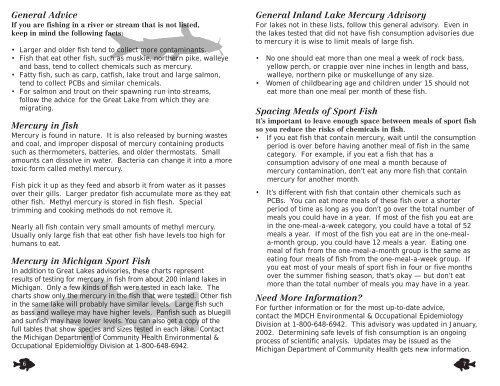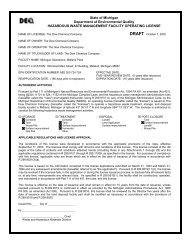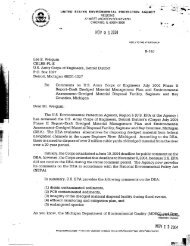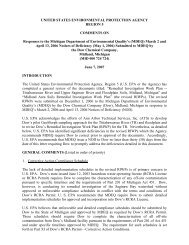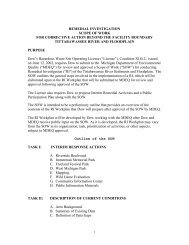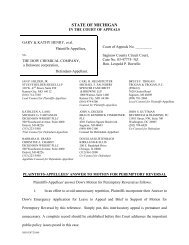Fishing Advisory_exp - Tittabawassee River Watch
Fishing Advisory_exp - Tittabawassee River Watch
Fishing Advisory_exp - Tittabawassee River Watch
Create successful ePaper yourself
Turn your PDF publications into a flip-book with our unique Google optimized e-Paper software.
General Advice<br />
If you are fishing in a river or stream that is not listed,<br />
keep in mind the following facts:<br />
• Larger and older fish tend to collect more contaminants.<br />
• Fish that eat other fish, such as muskie, northern pike, walleye<br />
and bass, tend to collect chemicals such as mercury.<br />
• Fatty fish, such as carp, catfish, lake trout and large salmon,<br />
tend to collect PCBs and similar chemicals.<br />
• For salmon and trout on their spawning run into streams,<br />
follow the advice for the Great Lake from which they are<br />
migrating.<br />
Mercury in fish<br />
Mercury is found in nature. It is also released by burning wastes<br />
and coal, and improper disposal of mercury containing products<br />
such as thermometers, batteries, and older thermostats. Small<br />
amounts can dissolve in water. Bacteria can change it into a more<br />
toxic form called methyl mercury.<br />
Fish pick it up as they feed and absorb it from water as it passes<br />
over their gills. Larger predator fish accumulate more as they eat<br />
other fish. Methyl mercury is stored in fish flesh. Special<br />
trimming and cooking methods do not remove it.<br />
Nearly all fish contain very small amounts of methyl mercury.<br />
Usually only large fish that eat other fish have levels too high for<br />
humans to eat.<br />
Mercury in Michigan Sport Fish<br />
In addition to Great Lakes advisories, these charts represent<br />
results of testing for mercury in fish from about 200 inland lakes in<br />
Michigan. Only a few kinds of fish were tested in each lake. The<br />
charts show only the mercury in the fish that were tested. Other fish<br />
in the same lake will probably have similar levels. Large fish such<br />
as bass and walleye may have higher levels. Panfish such as bluegill<br />
and sunfish may have lower levels. You can also get a copy of the<br />
full tables that show species and sizes tested in each lake. Contact<br />
the Michigan Department of Community Health Environmental &<br />
Occupational Epidemiology Division at 1-800-648-6942.<br />
6<br />
General Inland Lake Mercury <strong>Advisory</strong><br />
For lakes not in these lists, follow this general advisory. Even in<br />
the lakes tested that did not have fish consumption advisories due<br />
to mercury it is wise to limit meals of large fish.<br />
• No one should eat more than one meal a week of rock bass,<br />
yellow perch, or crappie over nine inches in length and bass,<br />
walleye, northern pike or muskellunge of any size.<br />
• Women of childbearing age and children under 15 should not<br />
eat more than one meal per month of these fish.<br />
Spacing Meals of Sport Fish<br />
It’s important to leave enough space between meals of sport fish<br />
so you reduce the risks of chemicals in fish.<br />
• If you eat fish that contain mercury, wait until the consumption<br />
period is over before having another meal of fish in the same<br />
category. For example, if you eat a fish that has a<br />
consumption advisory of one meal a month because of<br />
mercury contamination, don’t eat any more fish that contain<br />
mercury for another month.<br />
• It’s different with fish that contain other chemicals such as<br />
PCBs. You can eat more meals of these fish over a shorter<br />
period of time as long as you don’t go over the total number of<br />
meals you could have in a year. If most of the fish you eat are<br />
in the one-meal-a-week category, you could have a total of 52<br />
meals a year. If most of the fish you eat are in the one-meala-month<br />
group, you could have 12 meals a year. Eating one<br />
meal of fish from the one-meal-a-month group is the same as<br />
eating four meals of fish from the one-meal-a-week group. If<br />
you eat most of your meals of sport fish in four or five months<br />
over the summer fishing season, that’s okay — but don’t eat<br />
more than the total number of meals you may have in a year.<br />
Need More Information<br />
For further information or for the most up-to-date advice,<br />
contact the MDCH Environmental & Occupational Epidemiology<br />
Division at 1-800-648-6942. This advisory was updated in January,<br />
2002. Determining safe levels of fish consumption is an ongoing<br />
process of scientific analysis. Updates may be issued as the<br />
Michigan Department of Community Health gets new information.<br />
7


